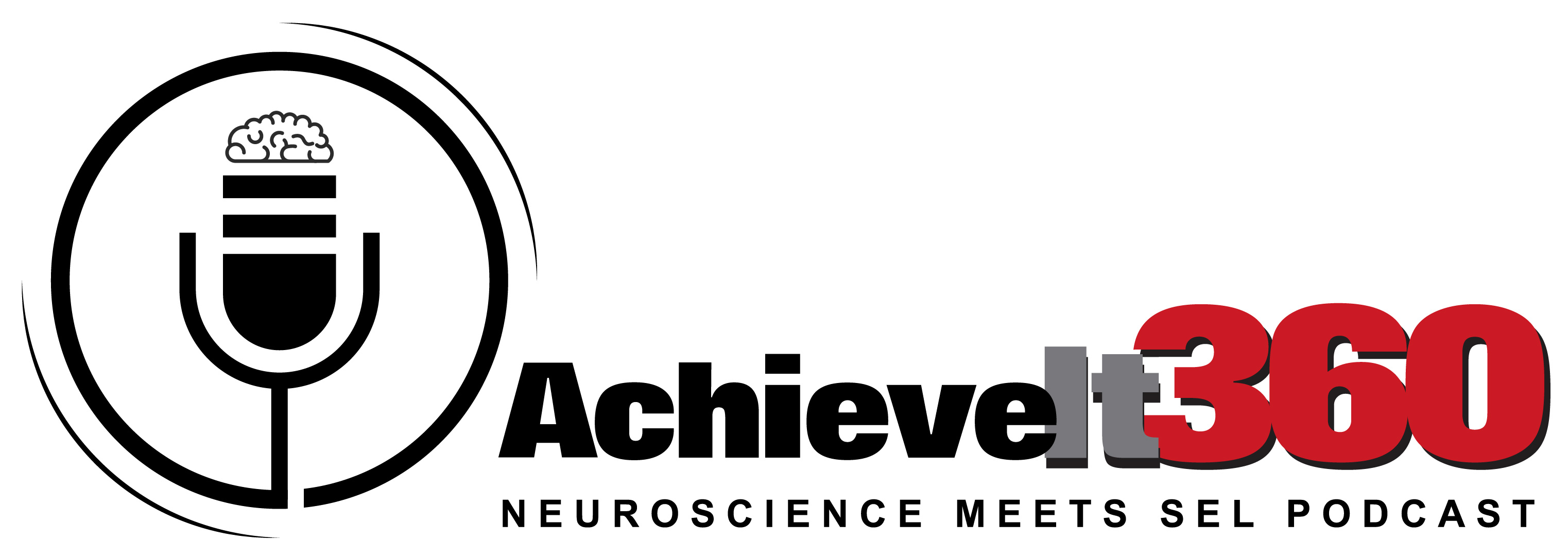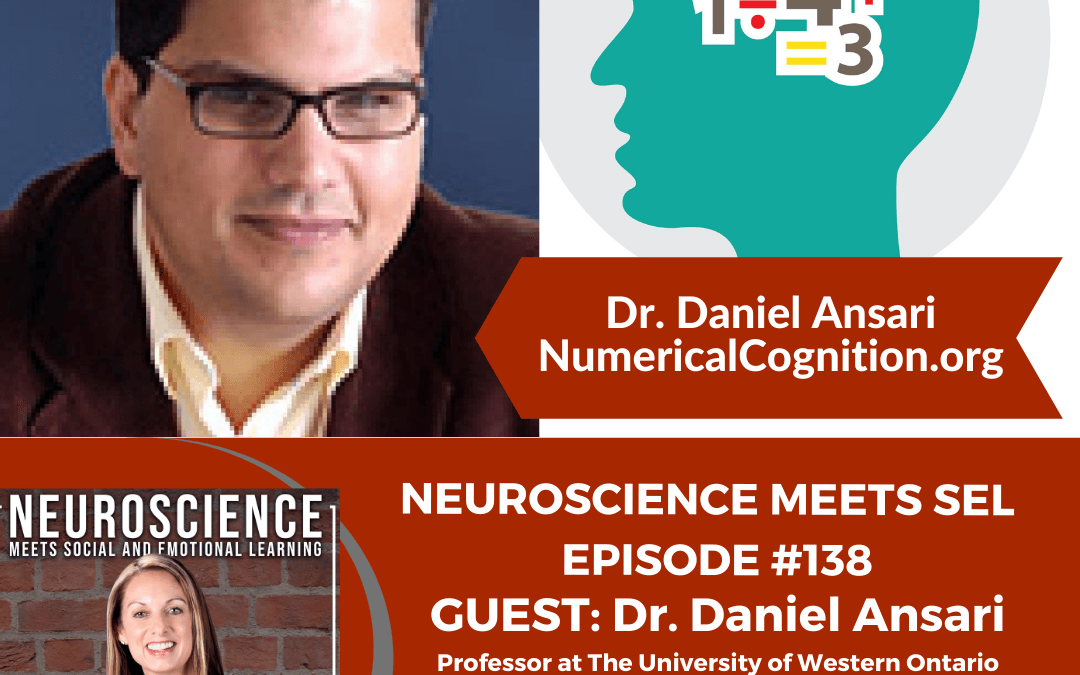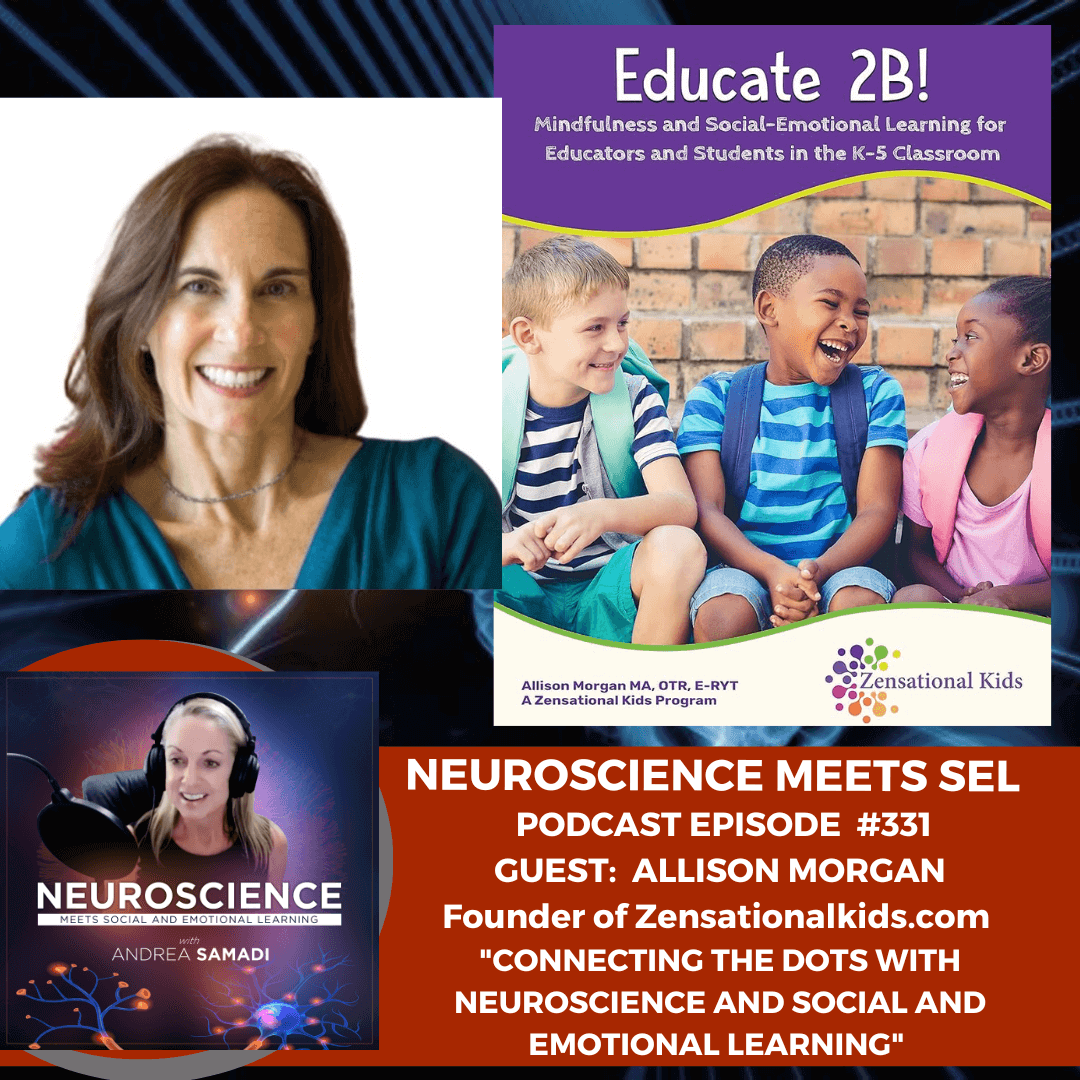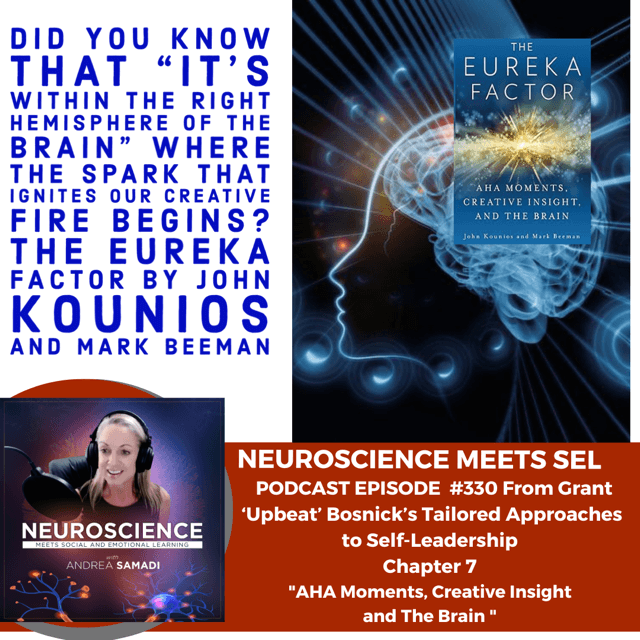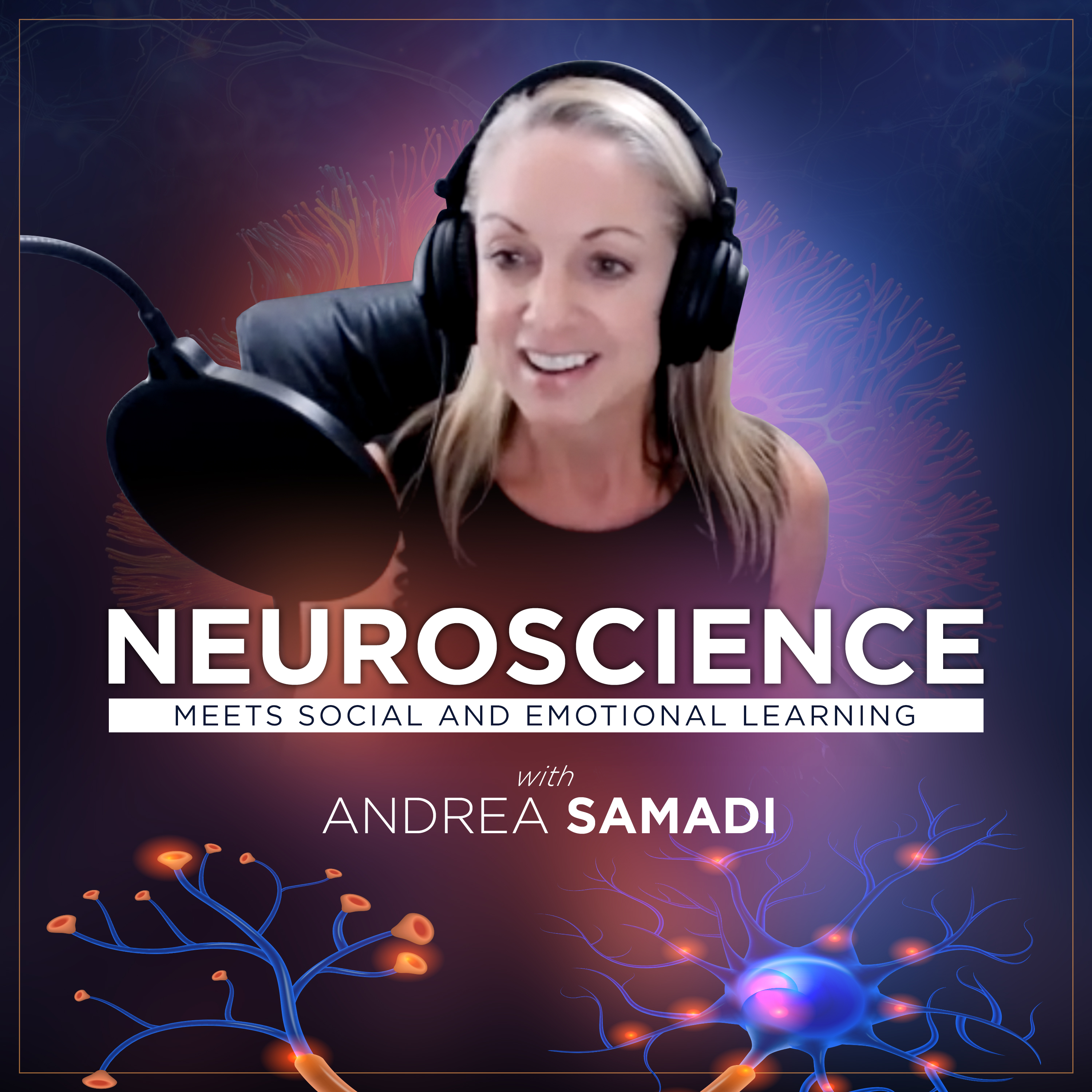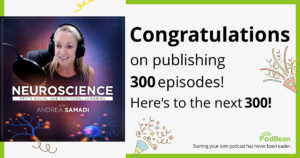Welcome back to the Neuroscience Meets Social and Emotional Learning Podcast, EPISODE #138 with Dr. Daniel Ansari[i], a professor and Canada Research Chair[ii] in Developmental Cognitive Neuroscience and Learning in the Department of Psychology and the Brain in Mind Institute[iii] at the University of Western Ontario in London, Ontario where he heads the Numerical Cognition Laboratory.[iv] His name is well-known in the field of educational neuroscience with a focus on numeracy and math which I know our listeners will find fascinating as we make connections with how children acquire math and numeracy, with brain science in mind.
You can watch the interview on YouTube here.
I’m Andrea Samadi, an educator who has been fascinated with understanding the science behind high performance strategies in schools, sports, and the workplace for the past 20 years. If you have been listening to our podcast, you will know that we’ve uncovered that if we want to improve our social and emotional skills, and experience success in our work and personal lives, it all begins with an understanding of our brain.
Our goal with this podcast is to bring the most current neuroscience research to you and make it applicable in your life whether you are a teacher in the classroom or using these ideas to improve productivity and results in your workplace. As I am researching and learning new ideas, I’m also implementing them myself, and making connections to past speakers, so that we can all benefit from the research that is emerging in this new field of educational neuroscience.
Which brings me to our next guest, who I came across a few months ago while researching neuroscientists who specialize in the field of education. Dr. Daniel Ansari’s name came up as a speaker at the Dropping Out, What Neuroscience Can Teach Us[v] International Symposium on the long-held paradigms of dropout prevention with his session on “The Best Way for Children to Learn Math” and my attention was caught. When I worked at Pearson Education, (2004-2010) I was on a sales team that had a focus on one product, for dropout prevention at the high school level (NovaNET)[vi] and I spent years promoting this program with the hopes of saving students who were at risk of dropping out. This conference was happening just as I had begun to study the brain and learning in 2015, and I only wish I had found it sooner. I wrote down Dr. Ansari’s name on my desk, with the idea that I would look him up, and see if he would come on the podcast as a guest.
Then went back to work on researching in the field of educational neuroscience and the researcher I am working with, Mark Waldman, sent me an article that he thought would be of interest to me with a project I am working on. I opened the article called “Annual Research Review: Educational neuroscience: progress and prospects”[vii] by Michael S.C Thomas, Daniel Ansari, and Victoria C.P. Knowland and immediately contacted Daniel Ansari. I don’t believe in accidents and when someone’s name continues to come to my attention as someone I need to learn from, I don’t waste any time. Without further ado, let’s meet Professor and Canada Research Chair in Developmental Cognitive Neuroscience and Learning, Dr. Daniel Ansari.
Welcome Daniel! I was so happy when you wrote back after I contacted you after reading your research abstract on educational neuroscience, thank you so much for being here.
Daniel, you let me know when I first contacted you that you were in lockdown in London, Ontario, Canada, that your son was doing his schooling in your office and as I am writing these questions, I saw that schools in Ontario (where I grew up, got my teaching degree, and was a teacher) have according to Professor Prachi Srivastava, a professor at Western University “the longest school closures in Canada. As of today (June 3rd), 23 weeks since March 2020).” What is going on with the schools in Ontario, and how do you think this is impacting student learning?
Q1: Dr. Ansari, when I first began to research this field of educational neuroscience, it was in 2014 when an educator urged me to go in this direction with the leadership/SEL program[viii] I created for middle and high schools, and there wasn’t a lot of resources to follow. There were books to read on learning and the brain and I have interviewed many of these leaders on the podcast (David Sousa, How the Brain Learns Series[ix], John Medina’s Brain Rules[x]) but I certainly had no idea there were undergraduate programs in this field. ((The term educational neuroscience came to me a few years later as I began to learn from Dr. Lori Desautels[xi], who runs the educational neuroscience graduate program at Butler University, but aside from her program, or taking a certification course like I am doing now from a leading researcher, I didn’t know of any pathway that an educator could take to learn more about the brain and how it impacts learning.)) Can you share how you came on this path, that took you from your work in England, to Dartmouth College’s first undergraduate program in neuroscience and perhaps your vision for where this field is going?[xii]
Q2: I’d love to dive into the work you are doing at Western University’s Numerical Cognition Lab where you are studying how children develop numerical skills. I’m sure that you hear this often, and it was the first thing that came across my mind when I began researching your work. Why did you put your focus on numeracy and math? What are the scientific and societal implications that you’ve uncovered to build a case for everyone to look mathematical skills with a new lens?
Q3: Now that you’ve built the case for the importance of numeracy and math for our students/children, and many students have been homeschooled for the past year, so this is information is important for parents, not just for those teaching in the classroom. What are some of the foundational numerical skills that our children/students should be proficient with by 3rd grade (since 3rd grade is such an important marker for literacy) and how can we be sure to not put our fear of math (if we have it) onto our students or children?
Q4: I watched the video on your website[xiii] that gives an overview of the work you are doing in your lab, and it caught my attention with the brain imaging you are doing to see how the brain’s structure and function impact our mathematical abilities. The only research I have come across so far on the brain and mathematics is David Sousa’s “How the Brain Learns Mathematics”[xiv] and in this book he says that with brain imaging they came across an interesting finding that he wasn’t sure was coincidental. They found “that the region of the brain that controls finger movement is the same region associated with counting”[xv] and he thought it was interesting that finger movement and counting are closely associated in the brain. Do you have any interesting findings like this (linking brain functions) that would be interesting and helpful for teachers learning to integrate brain science into their lessons, or parents homeschooling? What are you seeing with your brain scans?
Q5: We just released a podcast on a fascinating story of a child who had a developmental reading disorder, who failed 1st grade in 1994, yet went on to graduate with his Ph.D. from Oxford in 2018 with brain-based learning strategies. Can you explain a brief overview of Developmental Dyscalculia, how we can recognize it with our children/students and some strategies we could all use to help those who show the signs of this brain-based disorder, so it doesn’t dictate their future?
Q6: What is your vision for the future of education, and how educational neuroscience can advance our understanding of best practices to accelerate learning, social/emotional and academic?
Thank you for your time, research and strategies linking neuroscience to the future of learning. If people want to learn more about your work, I will put your website in the show notes numericalcognition.org and social media links Twitter @NumCog. Is there anything else we should know about that I have missed or any final thoughts?
Thank you, Dr. Ansari.
Dr. Daniel Ansari
Website http://www.numericalcognition.org/
Twitter https://twitter.com/NumCog
RESOURCES:
Dartmouth College Educational Neuroscience Undergraduate Program https://pbs.dartmouth.edu/undergraduate/neuroscience
Donna Coch Faculty of Education https://educ.dartmouth.edu/
Bridges over troubled waters: education and cognitive neuroscience by Daniel Ansari, Donna Coch March 10, 2006 https://pubmed.ncbi.nlm.nih.gov/16530462/
Casel’s SEL State Initiative https://casel.org/collaborative-state-initiative/
Neuroscience Meets Social and Emotional Learning Podcast EPISODE #77 with University Professors and Authors Douglas Fisher and Nancy Frey on “Developing and Delivering High Quality Distance Learning for Students” Published on YouTube August 4, 2020 H https://www.youtube.com/watch?v=7nLe3P50j4Q
The British Psychological Society https://www.bps.org.uk/
What is Number Sense? https://www.understood.org/en/learning-thinking-differences/child-learning-disabilities/math-issues/number-sense-what-you-need-to-know
How number-spaced relationships are assessed by Katarzyna Patro, Hans-Christopher Nuerk, Ulrike Cress, and Maciej Haman May 14, 2014. https://www.ncbi.nlm.nih.gov/pmc/articles/PMC4030170/
David Sousa’s “How the Brain Learns Mathematics” Sept. 19, 2007 https://www.amazon.com/Brain-Learns-Mathematics-David-Sousa/dp/1412953065
The Number Sense: How the Mind Creates Mathematics by Stanislas Dehaene April 29, 2011 https://www.amazon.com/Number-Sense-Creates-Mathematics-Revised/dp/0199753873/ref=sr_1_3?dchild=1&keywords=the+number+sense&qid=1623114414&s=books&sr=1-3
What explains the relationship between spatial and mathematical skills? A review of evidence from brain and behavior by Zachary Hawes and Daniel Ansari January 2020 https://link.springer.com/article/10.3758/s13423-019-01694-7
Hand 2 Mind Math Tool Kits https://www.amazon.com/hand2mind-Manipulative-Toolkit-Grade-Hands/dp/B07S259K8N
https://www.college-de-france.fr/site/en-stanislas-dehaene/presentation.htm
The relationship between finger gnosis and mathematical ability by Marcie Penner-Wilger and Michael Anderson December 5, 2013 https://www.ncbi.nlm.nih.gov/pmc/articles/PMC3851991/
The role of fingers in number processing in young children by Anne LaFay, Catherine Thevenot, Caroline Castel, and Michael Fayol July 30, 2013 https://www.frontiersin.org/articles/10.3389/fpsyg.2013.00488/full
Assisting Students Struggling with Mathematics: Intervention in the Elementary Grades March 2021 Institute of Education Sciences with Lynn S. Fuchs https://ies.ed.gov/ncee/wwc/Docs/PracticeGuide/WWC2021006-Math-PG.pdf
REFERENCES:
[i] Daniel Ansari https://www.edu.uwo.ca/faculty-profiles/daniel-ansari.html
[ii] https://www.psychology.uwo.ca/about_us/achievements.html
[iii] Brain in Mind Institute https://www.uwo.ca/bmi/
[iv] http://www.numericalcognition.org/
[v] Dropping Out, What Neuroscience Can Teach Us International Symposium, Quebec, Canada, 2015. https://www.edcan.ca/event/dropping-out-what-neuroscience-can-teach-us/
[vi] Pearson’s NovaNET https://www.pearson.com/content/dam/one-dot-com/one-dot-com/ped-blogs/wp-content/pdfs/dc1-pearsondigitallearning-novanet-research-based.pdf
[vii] Annual Research Review: Educational neuroscience: progress and prospects by Michael S.C. Thomas, Daniel Ansari and Victoria C.P. Knowland (April 2019) https://www.ncbi.nlm.nih.gov/pmc/articles/PMC6487963/
[viii] Andrea Samadi’s Level Up Program, Books and Tools for the Classroom https://www.achieveit360.com/courses/
[ix] Neuroscience Meets Social and Emotional Learning Podcast EPISODE #78 with David Sousa on “How the Brain Learns” https://andreasamadi.podbean.com/e/award-winning-author-david-a-sousa-on-how-the-brain-learns/
[x] Neuroscience Meets Social and Emotional Learning Podcast EPISODE #42 with Dr. John Medina on “Implementing Brain Rules in our Schools and Workplaces of the Future” https://andreasamadi.podbean.com/e/dr-john-medina-on-implementing-brain-rules-in-the-schools-and-workplaces-of-the-future/
[xi] Neuroscience Meets Social and Emotional Learning Podcast EPISODE #56 with Dr. Lori Desautels “Connections Over Compliance: Rewiring Our Perceptions of Discipline” https://andreasamadi.podbean.com/e/educational-neuroscience-pioneer-dr-lori-desautels-on-her-new-book-about-connections-over-compliance-rewiring-our-perceptions-of-discipline/
[xii] https://pbs.dartmouth.edu/undergraduate/neuroscience
[xiii] http://www.numericalcognition.org/
[xiv] How the Brain Learns Mathematics by David A Sousa Sept. 19, 2007 https://www.amazon.com/Brain-Learns-Mathematics-David-Sousa/dp/1412953065
[xv] How the Brain Learns Mathematics by David A Sousa Sept. 19, 2007 https://www.amazon.com/Brain-Learns-Mathematics-David-Sousa/dp/1412953065 Page 15
Podcast: Play in new window | Download
Subscribe: Apple Podcasts | RSS
